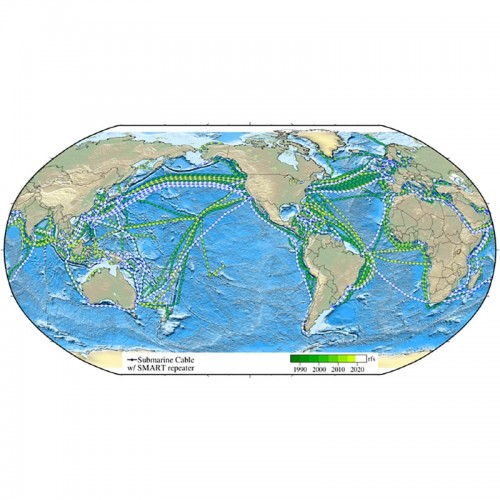Insight
6 April 2020
Thinking SMART On Telecom Cable Projects.

Subsea power and telecommunication cables have been changing the field of remote connectivity and bringing people together since the very first submarine cables were installed more than 150 years ago.
The importance of the power and data conveyed through these cables cannot be overstated today, billions of people around the globe rely on these cables, in one way or another, to facilitate their daily activities.
However, the past few decades have drawn our focus to another frontier in marine technology that of large-scale climate change. Our global oceans are undergoing unprecedented shifts in physical, chemical, and biological characteristics. Notably, global weather patterns such as the ENSO (El Niño - Southern Oscillation) cycle are also changing; the increasing strength and frequency of El Niño events have been attributed in part to anthropogenic causes and are having broad negative impacts across fisheries in the region. Likewise, an increase in inclement weather events, partnered with global sea level rise, could lead to an increased frequency of storm surges and tsunami-induced flooding among coastal areas.
One way in which we can counter and prepare for these events is by compiling good baseline data and continually monitoring the deep sea for any potential signs of disturbance. The Global Ocean Observing System (GOOS) is an international collaboration between scientists, the United Nations, and other stakeholders to compile and share as many relevant data points about the ocean as possible.
Benefits And Barriers To Outfitting Subsea Cables With SMART Technology
Compared to the ocean’s surface layers, the deep sea is relatively inaccessible and often requires large expeditions with significant funding in order to achieve the desired scale of data collection. Through partnering with existing and future subsea cable operations, GOOS hopes to develop a process for coupling telecommunication cables with data receptors to create SMART cables (Science Monitoring and Reliable Telecommunications). These cables will be fitted with sensors to continuously measure the variables of temperature, pressure, and seafloor seismic acceleration. In doing so, SMART cables would provide a continual, real-time, global dataset of critical information, allowing scientists to track any physical changes to the deep sea. According to a 2019 article in Frontiers in Marine Science, by monitoring seafloor seismic acceleration, SMART cables would be able to identify earthquake epicentres up to 21% faster than current programs, improving the tsunami warning system and potentially saving lives.
The need for global connectivity and information sharing is only going to increase in the coming years. As more subsea cables are installed, outfitting them to serve this dual purpose would go a long way towards creating a sustainable data source on which GOOS could rely for decades. While funding for the initial stages of research and installation remains a barrier, the SMART cable initiative would be highly beneficial, resulting in much denser sampling ability than current methods and virtually no maintenance costs after deployment.
In an age of grassroots carbon campaigns and increasing public awareness surrounding climate change, we anticipate scientific monitoring initiatives such as this to be very well received by the general public. Not only will SMART cables contribute to tsunami awareness projects, but they will also provide baseline data that could contribute to hundreds of scientific studies and increase our understanding of some of the most mysterious deep-sea landscapes in the world.
This could be an ideal opportunity for telecom companies to participate in a purposeful initiative that will greatly increase the scope of the science surrounding the deep ocean, all while utilizing their current infrastructure without interrupting any of their critical processes. So now we pose the question of which of our industry partners is ready to explore the possibilities?
For more information, please see the following sources:
ITU/WMO/UNESCO IOC Joint Task Force https://www.itu.int/en/ITU-T/climatechange/task-force-sc/Pages/default.aspx
Howe, B. M. et al. SMART cables for observing the global ocean: science and implementation. Frontiers in Marine Science 6, 424 (2019).
Timmermann, Axel & JM, Oberhuber & Bacher, A & ESch, M & Latif, M. & Roeckner, E. (1999). Increased El Niño Frequency in a Climate Model Forced by Future Greenhouse Warming. Nature. 398. 694-697. 10.1038/19505.
